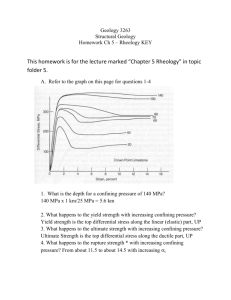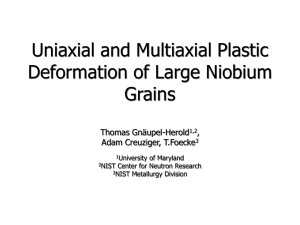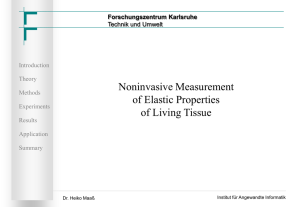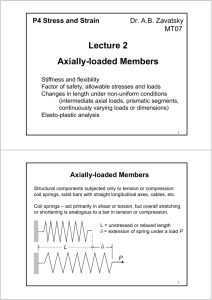DOC - MIT
advertisement
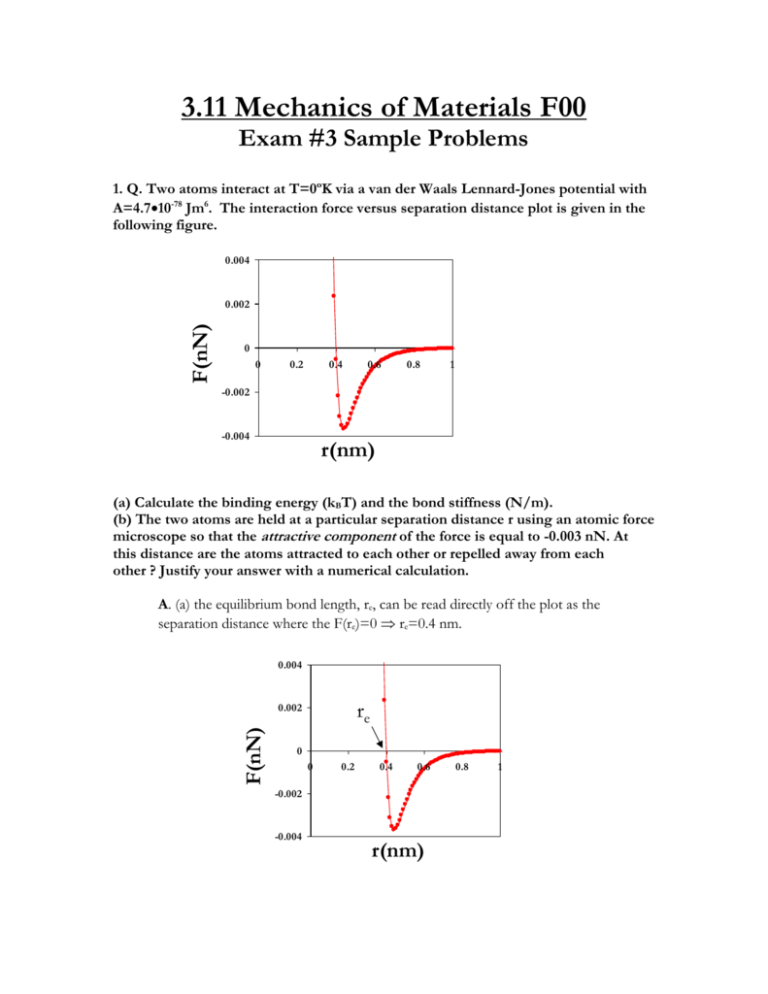
3.11 Mechanics of Materials F00 Exam #3 Sample Problems 1. Q. Two atoms interact at T=0ºK via a van der Waals Lennard-Jones potential with A=4.710-78 Jm6. The interaction force versus separation distance plot is given in the following figure. 0.004 F(nN) 0.002 0 0 0.2 0.4 0.6 0.8 1 -0.002 -0.004 r(nm) (a) Calculate the binding energy (kBT) and the bond stiffness (N/m). (b) The two atoms are held at a particular separation distance r using an atomic force microscope so that the attractive component of the force is equal to -0.003 nN. At this distance are the atoms attracted to each other or repelled away from each other ? Justify your answer with a numerical calculation. A. (a) the equilibrium bond length, re, can be read directly off the plot as the separation distance where the F(re)=0 re=0.4 nm. 0.004 re F(nN) 0.002 0 0 0.2 0.4 0.6 -0.002 -0.004 r(nm) 0.8 1 re=[2B/A]1/6 (1) Solve equation (1) for : B=Are6/2 (2) Substitute in equation (2) known values for re and A : B=(4.710-78Jm6)(0.410-9m)6/2=10-134 Jm12 EB=-[A2/4B]=-[(4.710-77Jm6)2/410-134 Jm12]=-5.52210-22JkBT/4.110-21J EB =-0.135kBT kbond=42A/re8-156B/re14=424.710-77Jm6/(0.410-9)8-15610-134 Jm12/(0.410-9)14 kbond=0.3 N/m (b) F=-6A/r7+12B/r13 Fattractive=-6A/r7(3) Frepulsive=12B/r13(4) Solve equation(3) for r r=[-6A/-Fattractive]1/7 r=[-64.710-77Jm6/-0.00310-9N]1/7=0.5 nm Substitute r and B into equation (4) Frepulsive=1210-134 Jm12/(0.510-9m)13 Frepulsive=0.0009 nN Fnet= Fattractive+Frepulsive=-0.003 nN+0.0009 nN Fnet=-0.00262 [NET FORCE IS ATTRACTIVE] 2. Q. (a) Calculate the true stress necessary to deform a rubber material of initial length, Lo= 0.1 m to Lf=0.2 m in uniaxial tension assuming the Gaussian theory of rubber elasticity and a reasonable value for the Young's modulus. (b) An elastomer that is put in a liquid solvent typically exhibits a macroscopic increase in volume, i.e. it "swells." Explain the molecular origin of this phenomenon in a few sentences. A. (a) The stress versus strain law for the Gaussian theory of rubber elasticity is : xkBT(2) (1) where : =Lf/Lo=2 (2) E=3xkBTxkBT=E/3=0.5MPa/3=0.166 MPa (3) Substitute (2) and (3) into (1): MPa (2)= 0.2905 MPa t(+1) == t0.2905 MPa (+1)=0.581 MPa (b) An elastomer is a chemically crosslinked polymer structure where the chains between crosslinks are "random coils" due to entropic considerations. The solvent molecules enter the network producing an expansion force that expands the polymer chains isotropically in all directions, thus causing a macroscopic increase in volume. swollen network dry network equilibrium random coil configuration solvent expansion force crosslinks network “strand” solvent molecules 3. Q. Derive the governing differential equation (T as a function of T) for the following viscoelastic model in terms of k1, k2, T,T k1 k2 T,T A. The governing equations for the individual elements are shown below : T,T 2=k22 1=k11 D= • D T,T In series the strains are additive, stresses equal In parallel the strains are equal, stresses additive T21D (1) T2(2) where : 1D Tk2TTk2T take time derivative of equation (1) : dTdt=d1dt+dDdt dTdt=d/dt)/k1 substitute (3) into (4) : dTdtdT/dt)/k1k2dT/dt)/k1Tk2T/ rearrange : dT/dt)/k1TdTdtk2T/k2dT/dt)/k1 4. Q. The macroscopic uniaxial stress versus strain curve for a ductile polycrystalline metal is given in the Figure below. Explain what molecular or microscopic level phenomenon dominate the response in each of the labeled regions of the curve (*give one or two sentences for each region). Y • • IV. I. II. III. V. • A. • f I. Linear Elasticity : crystalline lattice strain dominates, i.e. bond stretching, bending, twisting. II. Strain Hardening: dislocation movement, slip on crystallographic planes closest to 45o, dislocation pile-up within and at grain boundaries III. Necking : unstable decrease in cross-sectional area with increasing strain due to plastic deformation described above IV. Fracture : Separation of the material into new surfaces through bond breaking, the formation and propagation of a cracks V. Elastic Strain Recovery : the leftover intact material recovers its elastic lattice strain


